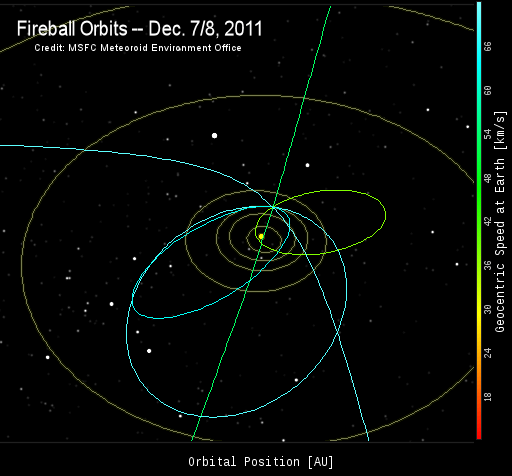Don't just watch shooting stars. Wear them! Authentic meteorite jewelry for Christmas is now available in the SpaceWeather Store. | | |
TOTAL LUNAR ECLIPSE: Mark your calendar. On Saturday, Dec. 10th, the full Moon will glide through the coppery shadow of Earth, producing a total lunar eclipse visible from the Pacific side of our planet. For residents of the western USA and Canada, the event unfolds at dawn and will be magnified to super-sized proportions by the Moon illusion. [Science@NASA: full story, video]
SOLAR ACTIVITY: After days of quiet, two new active regions are rotating over the sun's eastern limb, heralding a possible uptick in solar activity. One of them erupted during the late hours of Dec. 7th, shown here in a movie from NASA's Solar Dynamics Observatory:

The untwisting magnetic filament hurled a fragment of itself into space but Earth was not in the line of fire.
The potential of these regions for more eruptions will become clearer as they turn toward Earth in the days ahead. For now, NOAA forecasters estimate a 20% chance of M-class solar flares during the next 24 hours. Solar flare alerts: text, phone.
CONGESTED INTERSECTION: Ranging in size from microscopic space dust to mountainous asteroids, trillions of meteoroids zing through the inner solar system on a daily basis. What are the odds that five of them would cross the same point in space? Pretty good, actually. In fact, it happened just last night. Regard the following orbit diagram, then read on for an expanation:

These are the orbits of five objects that hit Earth on the night of Dec. 7/8. NASA’s All Sky Fireball Network recorded the meteoroids as they disintegrated in the atmosphere over the United States, each one producing a bright fireball. Note how all the orbits converge on a single point--our planet.
Every night the network's cameras scan the skies over the United States, forming an inventory of what hits the atmosphere. Combining images from multiple cameras, network software rapidly calculates the basic parameters of each interloper: orbit, speed, disintegration height, and more. At the moment, cameras are located in only four states (New Mexico, Alabama, Georgia, Tennessee), but the network is expanding to provide even better coverage. Soon we'll see just how congested our intersection in space really is. Stay tuned.
Potentially Hazardous Asteroids (
PHAs) are space rocks larger than approximately 100m that can come closer to Earth than 0.05 AU. None of the known PHAs is on a collision course with our planet, although astronomers are finding
new ones all the time.
On December 8, 2011 there were 1272 potentially hazardous asteroids.
Notes: LD means "Lunar Distance." 1 LD = 384,401 km, the distance between Earth and the Moon. 1 LD also equals 0.00256 AU. MAG is the visual magnitude of the asteroid on the date of closest approach. | | The official U.S. government space weather bureau |
| | The first place to look for information about sundogs, pillars, rainbows and related phenomena. |
| | Researchers call it a "Hubble for the sun." SDO is the most advanced solar observatory ever. |
| | 3D views of the sun from NASA's Solar and Terrestrial Relations Observatory |
| | Realtime and archival images of the Sun from SOHO. |
| | from the NOAA Space Environment Center |
| | the underlying science of space weather |

